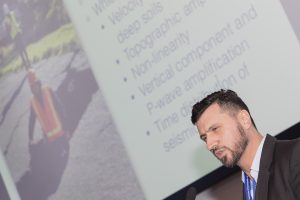Traditional earthquake early warning systems detect the fast-moving, but less-powerful P-waves that radiate from an earthquake. From there, they quickly estimate the earthquake’s location and magnitude and send out an alert, often just seconds before the more powerful S- waves arrive.
But what does that alert mean for the building you’re currently in?
It’s a question that Stefano Parolai, director of the Seismological Research Centre at the National Institute of Oceanography and Applied Geophysics (OGS) in Italy, works to answer.
“We’re working to customize earthquake early warning alarms to particular structures,” he says. “It’s what we call decentralized on-site early warning.”
These systems consist of sensors placed on (or near) buildings ranging from apartments and skyscrapers to industrial facilities. The sensors also detect P-waves, but rather than predicting the location or magnitude, they estimate “what the level of damage to a structure could be in the shaking that’s coming.”

On-site early warning systems can also be tied to other safety mechanisms. For example, PG&E recently installed a system in the elevators of their downtown San Francisco office building. When a strong earthquake is detected, the elevators stop at the nearest floor and open, giving those inside a chance to reach a safer place before the shaking starts. Other systems include automatic shut-offs for pipelines or reactors.
While on-site early warning systems are a popular topic in seismology – and one of Parolai’s primary research interests – he says their development requires a multidisciplinary approach.
“We need to combine the seismological knowledge of the level of shaking with the engineering knowledge of how a structure will behave under a certain level of ground shaking.”
Standing at the intersection of seismology and engineering, Parolai has trained extensively to bring the two fields together. After receiving his Ph.D. in geophysics in 1997 from the University of Genoa, he wanted to contribute his expertise more directly to society. He landed on engineering seismology, a field he saw as being “a little more practical.”
Over time, his interests broadened to seismic hazard and risk analysis. From there, early warning systems became a natural fit. From 2012 to 2017, he served as director of the Center for Early Warning Systems at the GFZ Potsdam in Germany.
“In engineering, there’s a lot of estimation of risk for long-term scenarios, let’s say what can happen in the next tens to hundreds of years or so,” he says. “Early warning can be seen as a very rapid risk assessment.”
Parolai has had an active role in Europe’s earthquake early warning systems, including the REAKT (Strategies and tools for Real Time EArthquake RisK ReducTion) and SAFER (Seismic Early Warning for Europe) projects.
“There are already areas in Europe where we are testing earthquake early warning, like in Istanbul and Bucharest,” he says. “On the scientific level I think it’s quite advanced, both for regional and on-site early warning systems.”
The next step for these projects is making the systems more widespread, but Parolai explains there are still difficulties – including those beyond the scientific or technical realm.
“When you’re dealing with early warning systems, you have to imagine that due to the impact the alarm can have, you’re not only dealing with scientific issues but also legal and governmental aspects,” he says.
“Early warning systems must involve natural scientists and engineers, but also social scientists for their capability of communicating a risk, preparing people for how to receive an early warning and how to behave.”
Going beyond the science is part of Parolai’s job. As director of research at OGS, he has to be both scientist and manager.
“I’m managing quite a large team, with 50 people in the department for Seismological Research,” he says. “The big challenge is coordinating the research between all the different groups and harmonizing the research between them.”
One of the risks he sees in larger organizations is everyone going in their own direction. “You miss the opportunity to find links between the research in the different fields that could be useful for others.”
Parolai also serves as general secretary for the European Seismological Commission, which is hosting its 36th General Assembly 2-7 September 2018.
“We’re organizing working groups between different scientists at the European level,” he says. “My main task is trying to bring together these scientists and facilitate cooperation, especially between seismologists and engineers.”
Looking forward, Parolai dreams of one day being able to see the effects of an earthquake on structures “like a movie in 3D.”
“A big dream for everyone working in engineering seismology is to have a huge number of sensors on the surface, underground and in building structures,” he says. “Then we could really understand how waves are propagating and see what a structure contributes to the shaking.”
That goal may not yet be accessible for Parolai and his colleagues, but it’s not something that bothers him.
“We are very lucky people,” he says. “As researchers we can follow our dreams in our job and use our brain and that’s really fantastic.”
